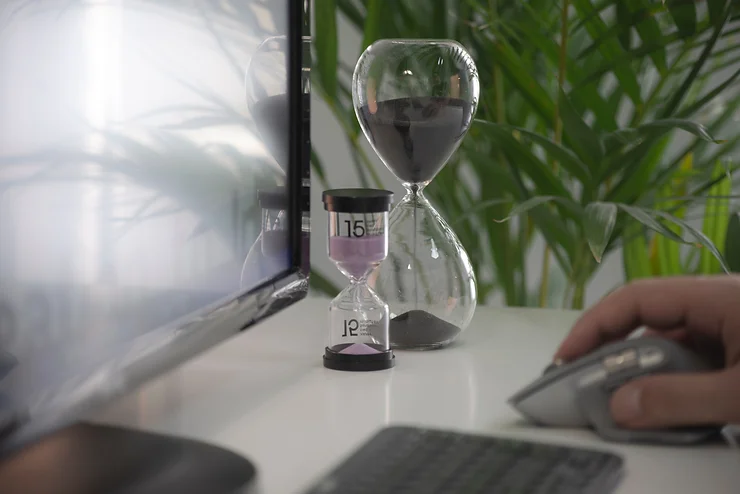You can always find a distraction if you’re looking for one – Tom Kite
Dear friend,
Today, it’s common to work in offices where we sit together with other people. While this makes working more fun, it poses a massive distraction potential. Whether it’s someone having a call, chatting with another colleague, asking you a question, or telling a joke, in a shared office – no matter if cubicle or open office – you’ll be distracted multiple times a day.
Distractions aren’t bad per se, but when it comes to doing “knowledge work”, they significantly worsen our productivity. Knowledge work, such as reading a scientific paper or setting up an Excel sheet, requires brainpower and a state of deep focus. When we are distracted, though, we lose our focus and it takes minutes to regain the level of it prior to the distraction.
I continuously search for ways to optimize my productivity, and so, I try to minimize distractions. There are various techniques and gadgets to remove them from our work. In today’s blog article, I will show you a simple trick that helped me to reduce external distractions and boosts my productivity.
Summary:
- Returning to our original focus following a distraction takes multiple minutes, worsening the quality of our work
- Managing distractions at work may be the best solution rather than avoiding them altogether
- As a rule-of-thumb, we can assume that our brain can work in deep focus for about 4 hours a day
Practical advice:
- Buy yourself a pair of noise-canceling headphones
- They are a game-changer in terms of effectiveness and easiness to implement
- Every pair of on-ear noise-canceling headphones does the job. If you want to spend some money, though, the Sony WH-1000xm4 is currently the way to go
Why distractions are bad for us
Our brains have a limited ability to focus. We can’t pay attention to everything around us all at once, so we must choose what to focus on. When we work on something requiring our full focus, a distraction makes us lose our focus as it switches to the distraction at hand.
Research shows that returning to our original focus following a distraction takes multiple minutes. What’s even worse, though, is the quality of our work worsens significantly. While it doesn’t take much longer to perform a task, such as writing a mail, we compensate for the time and focus we lost through the distraction by lowering our quality standards. For instance, once we’re interrupted while doing a task, the odds increase that we’ll forget an important step in the process.
Chances are we may even forget to return to the original task. Nearly half the time, distractions cause us to forget where we left off. Other times, the task has gotten completely out of control and we have to start over.
When distractions are welcome
As written, distractions aren’t bad per se. Our brains have a limited “amount of deep focus”. Once we reached this limit, we need a break. Otherwise, our brain cannot really produce any good results. Then, distractions are a great way to give our brains time to rest.
By allowing occasional distractions to interrupt our work, we take the pressure off our thinking processes and allow the subconscious to breathe. Refreshed, we can return to our task with a new approach developed by our subconscious and do the tasks faster and better.
Therefore, managing distractions at work may be the best solution rather than avoiding them altogether. This means that we need to (A) learn when and how long we should seal ourselves off from distractions and (B) find reliable means to do so.
(A) As a rule-of-thumb, we can assume that our brain can work in deep focus for about 4 hours a day. This means that on a typical workday, we should ideally protect ourselves from distractions 50% of the time.
(B) Potent means to seal ourselves off from distractions that greatly help me are (1) putting my smartphones in “non-disturb” mode (2) closing my mailbox and slack (3) putting on noise-canceling headphones.
Noise-canceling headphones
While there’re many means to limit (external) distractions, only a few are as easy to implement and as effective as noise-canceling headphones. It’s really surprising how simple and yet effective this “trick” is when I first tried it out. When I wear my on-ear headphones to limit distractions, my focus is on another level. Simultaneously, chances that I’ll be distracted by something external, such as a colleague or a silly noise, decreases substantially. For me, it’s a “game-changer”.
But why does that work so effectively and what do you need actually need?
Noise-canceling headphones are so effective because of 4 reasons:
(1) They are a super simple solution. You just put them on and that’s it.
(2) Colleagues and other people clearly see that you have them on. Chances that they will distract you drop.
(3) Chances that you’re distracted by external factors, such as colleagues having a call, telling a joke or silly random noises, are significantly reduced.
(4) You’ll develop a habit when you start wearing them whenever you need to focus on something (Trigger: You start wearing your headphones. Habit: You focus on a task. Reward: You get your task done more effectively). Thereby, you reinforce the effect as your brain learns to frame the situation as “it’s time to focus now”.
I tried different things that could do the same as in-ear headphones or different types of earplugs, but they aren’t either as easy to implement or as effective as on-ear headphones.
From my experience, every pair of on-ear noise-canceling headphones does the job. If you want to spend some money, though, the Sony WH-1000xm4 is currently the way to go. Every tech influencer talks about them.


